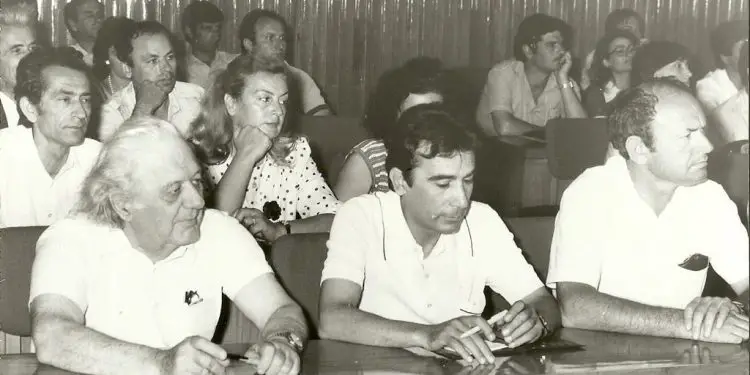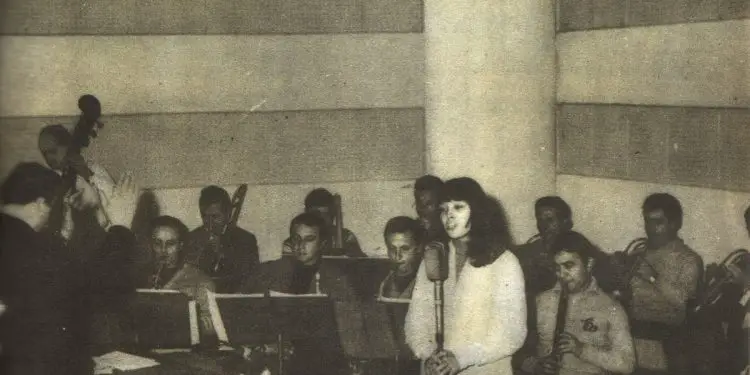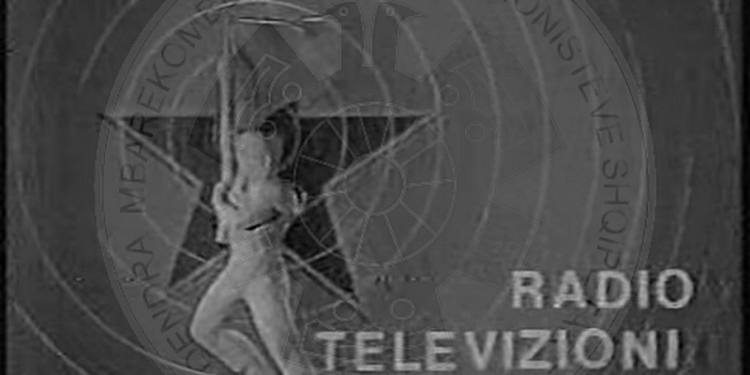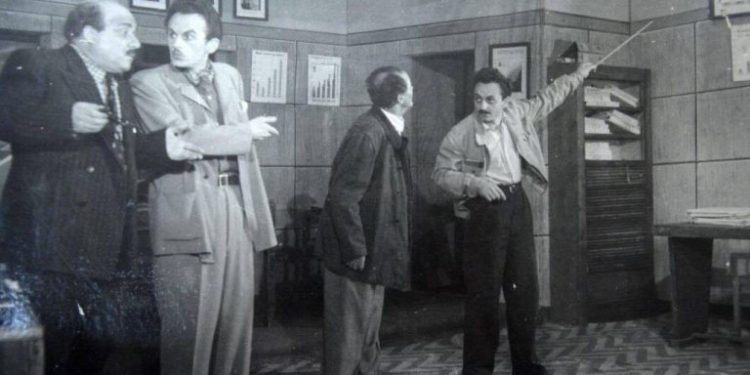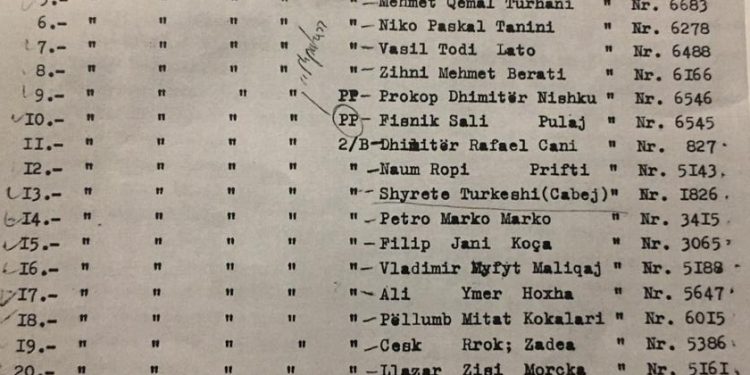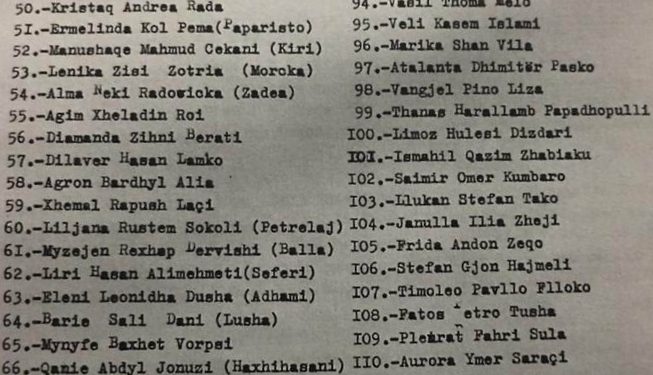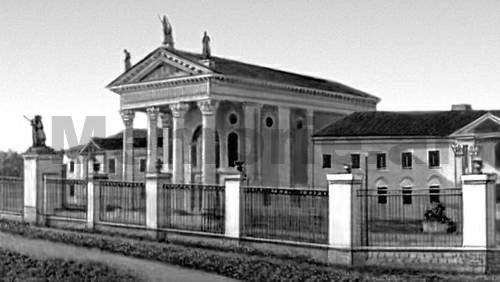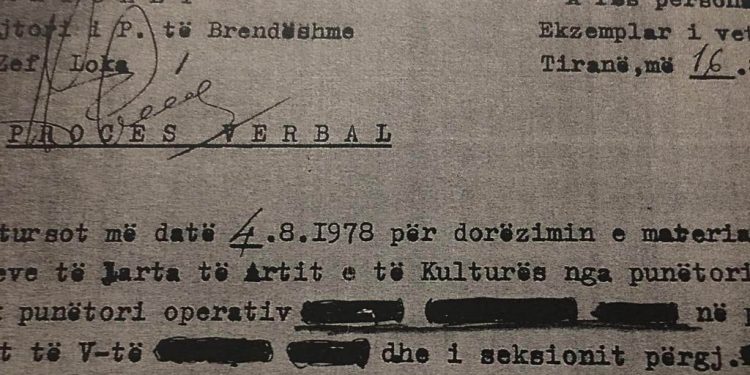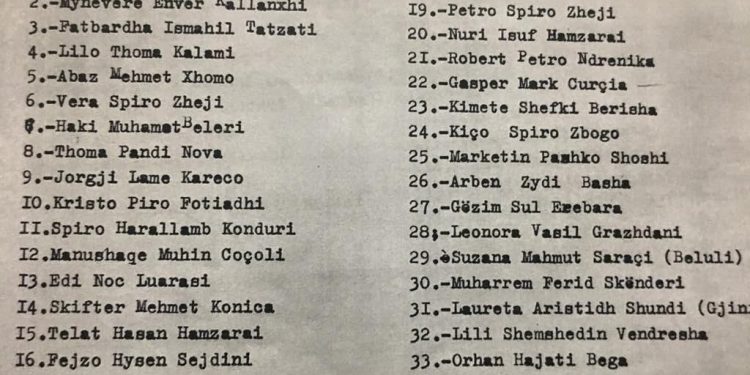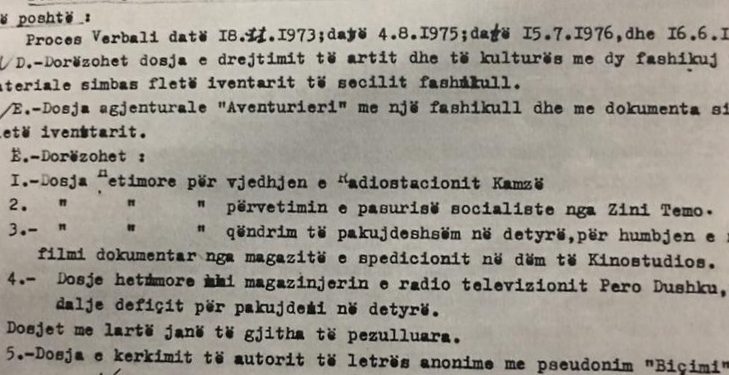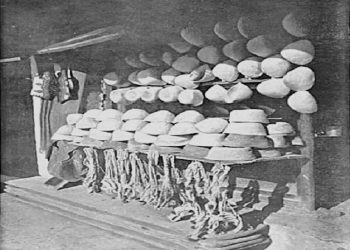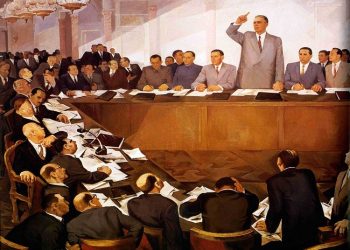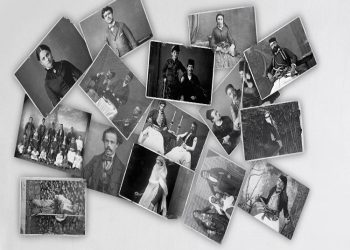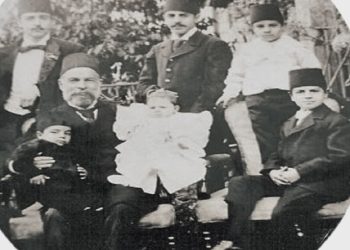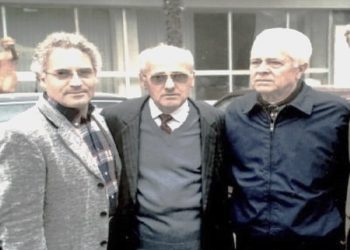Dashnor Kaloçi
Memorie.al publishes an archival document with the logo “Top secret” extracted from the archives of the former State Security with a list of 315 names of intellectuals from the cultural and artistic institutions of the capital such as: Vaçe Zela, Rikard Ljarja, Ndrek Luca, Sali Shijaku, Edi Luarasi, Marie Kraja, Naum Prifti, Bujar Kapexhiu, Helena Kadare, Gëzim Erebara, Luigj Gurakuqi, etc., which determines the reason for following their surveillance, as well as the interview of the former senior Security staff of the State regarding this list …
A long list of about 315 names of intellectuals of the Albanian scene, screen, art, culture and literature, including many prominent personalities such as; Vaçe Zela, Rikard Ljarja, Sali Shijaku, Marie Kraja, Naum Prifti, Bujar Kapexhiu, Elena Kadare, Gëzim Erebara, Luigj Gurakuqi, etc., were subject to surveillance and prosecution by the State Security organs during the communist regime of Enver Hoxha. The document that we are publishing below, which has been extracted from the archives of the Albanian state and which bears the initials “Top secret” belongs to 1978. The file in question, from which the list with the names of 315 intellectuals of the capital is extracted, is in the file of the operating worker who served in that period of time, who, due to his transfer to another duty, handed it over to the next colleague. The list of 315 intellectuals is categorized into several groups, such as: “Registered persons belonging to the Directorate of Counterintelligence”, “Persons belonging to the direction of Counter-Revolutionary Groups”, etc. But in order to have a clearer idea of what that file contains, what it has served for and why it contains some of the most famous names of Albanian art, culture and literature before the ’90s, we turned to a short interview, or rather for an explanation, one of the former senior officials of the former State Security, who preferred to remain anonymous. The interview in question, of course, could have been much longer and with a lot of clarification, but we are publishing it below as much as we could get from the former senior State Security official, without making any changes.
Is this document we are publishing below authentic and why did it serve?
Yes, this document is 100% authentic and is one of the documents of that period, ie before the ’90s, when our State Security weapon worked. This document is about the handover and taking over of duty by two officials of the State Security, and as such, in this time context, it should be seen for the time when it comes to it. Let us dwell more specifically on your question: As a rule, the process of taking and leaving office lasted a month, and this was based on the regulations and orders of the Ministry of Interior. During this month, two processes were carried out. The incumbent would sign that he was familiar with all legal procedures, normative acts, regulations, etc. In this process, the assignment was realized: A – Agency, (Information Network), the assignor knew the assignee, with physical contacts with the agency, according to the monthly meeting schedule. In this process, the connection was made, and the ethics were respected with the respective thanks for the work done up to that moment. B – Receipt of all documentation.
What document was received?
Documents related to the agency, work files and personal files, (Personal files, were more or less like staff files yesterday and today). The Work Files summarized all the work material reported by the agent: The harmonization of the physical contact with the study of the documentation, realized the receipt of the secret information network. Received …… 2-O. R. V (Objects of Special Importance). Objects which were judged to be of special importance, due to their specific character, from the economic, political, or scientific point of view. These institutions (O. R. V) were secured and guarded by military, police, and intelligence measures. For example, the Albanian Radio-Television had military and police units. The broadcast booth (news studio) was guarded by armed police every 24 hours. Radio stations, such as Fllaga, Cërriku, etc., were guarded by military, police, and agent forces, at every point. Let’s go back to the Albanian Radio-Television mentioned above: The whole secret information network was almost in the technical sphere, and almost non-existent in the newsrooms, programming, or other departments.
Who were the other O. R. V. objects?
Other objects O. R. V, were also; hydropower plants, water supply systems, bread factories, etc. C-Files Object to be followed: 1-General Information Folder or Folder in which the security service, collected information, data, facts, comments, opinions, etc., which served as a raw material for information, reports, or analysis, that this service sent to the top leadership of the country (Central Committee of the ALP and the Politburo). P. Sh.: In the list published below, there is also the name of Vaçe Zela, the famous singer before the ’90s. According to the information gathered on the operational road, Vaçja, but also many other artists, had the view and thought that the financial treatment of our artists, mainly during tours abroad, was not dignified and in inverse proportion to the contribution of these artists to growth of the country’s popularity in the world. For many reasons, this claim was not transmitted in institutional, legal, open ways, but in this case the Security service intervened and took the information up to the leadership.
So, for all these people who spoke and expressed dissatisfaction against the regime, a file was opened and their name was added to the list to be monitored and followed in relation to this problem…?!
In principle yes, but it should be said that the list or documents published below, which were part of the file or information file, were not subject to prosecution by the Security, but a reference point, for communication with the political leadership. This list was regulated, to be analyzed once in three months by the respective chief, and if the problem was considered exhausted, it was deleted with regular minutes. As a part was hidden, something else could be added that brought out the dynamics. If the following list is from 1978, in 1983, with the replacement of the relevant operating worker, it will be seen that it is a completely different list from this. In conclusion, the lists, an integral part of the informant’s general file, are not an operational follow-up list.
But what are operational tracking files?
Your question is correct and here I wanted to get out? -What are the operational tracking files? 1-P. P (Preliminary Processing). It is tracking which aims to verify the collected data. In case the data was confirmed, the person continued to be pursued and turned into an object of implementation of all types of operational work. If the information was not confirmed, the person was removed from the list and the material was destroyed. The data verification period was three months. Tracking File 2 A: It was the process of following up and implementing all operational measures with the agency, as the case may be with witnesses, with the tools of the operating technique (TO), with the agency, with postal and telephone control, etc., thus applying the observation of person, if the situation required it. The prosecution was carried out only for the crime figures provided by the Criminal Code of the RPSSH, and each figure had its own respective deadlines for operational prosecution. For illustration, we are giving the terms of the operational prosecution according to the crime figures. A-Agitation and Propaganda, not more than 1 year, B-Terror, as soon as possible, and not more than 3 months, C-Escape, 6 months, D-Espionage, 5 years. These deadlines were strictly defined. After completing the documentation and the relevant procedure, act as appropriate. 3-Closing Forms: Counseling, arrests for flagrant cases, withdrawal from cooperation with compromising material, etc. These documents were archived at the Ministry of Interior. Files 2 B: It is for operational control. These were files for people who had once been in illegal activity but over time had given up, or were advised to do so, but could potentially be reactivated. For these subjects there was the possibility of resumption of hostile activity. For this reason, they were occasionally observed. Likewise, these files were viewed for their historical qualities.
Who for example?
For example, in this case is the example of Petro Marcos. In whose file, you can find documents, reports of the Italian SIM, about Marco’s activity in exile, relations about his friendship with Mehmet Shehu in the Spanish War, his considerations for the Albanian political emigration, etc. Because of this wealth, this or other files like this, are reserved for scholars. So according to this brief explanation I gave you above, whoever reads his name in a document like the one you are publishing, is free to judge for himself whether he has been in operational pursuit or not? And this is especially true for which. Who are looking for a non-existent dissidence…?!
Finally, what can you add?
In this record that you are publishing, in other words, an administrative act, there is also a list of names considered contingent. This category includes elements which, from the information or documents, turn out to be politically “unacceptable”. These lists were also not permanent, but the positions were clarified and removed, or new ones were added. These also applied to a control of high political denominations. The senior political leadership, from time to time, sought to appoint various persons to senior state positions and may seek clarification in the State Security service or bodies. It was up to the policy judge whether to consider the information received or not. It depended on them.
APPROVED: Deputy Director of Internal Affairs Zef Loka.
“Res personal”. Single copy. Tirana, on 16.8.1978
VERBAL PROCESS
Held on 4.8.1978 for the submission of materials of the sector of Higher Institutions of Art and Culture by the operational worker ……… in the presence of the head of the V section ………. And of the responsibility section ……… The materials are submitted as follows:
Form files 2 / A: PP and 2 / B. Object form file 2 / A.
Barbara Haxhihyseni, Engjell Tërshana, Adriatik Kanani, Asamble Hatibi, Mehmet Qemal Turhani, Niko Paskal Tanini, Vasil Todi Lato, Zihni Mehmet Berati, Prokop Dhimitër Nishku, Fisnik Sali Pulaj, Dhimitër Rafael Cani, Naum Ropi Prifti, Shyrejte Turkesh M Marko, Filip Jani Koça, Vladimir Myfit Maliqaj, Ali Ymer Hoxha, Pëllumb Mit’hat Kokalari, Çesk Rrok Zadeja, Llazar Zisi Morcka, Konstandin Vangjel Trako, Beniamin Zef Guraziu, Jusuf Fehmi Kazazi, Bujar Fiqiri Kapexhiu.
Personal Account Book with the following contingents:
Tonin Lec Harapi, Mynevere Enver Kallanxhi, Fatbardha Ismail Tatzati, Lilo Thoma Kalami, Abaz Mehmet Xhomo, Vera Spiro Zheji, Haki Muhamet Beleri, Thoma Pandi Nova, Jorgji Lame Kareco, Kristo Piro Fotiadhi, Spiro Harallamqe Konduri, Manus Luarasi, Skifter Mehmet Konica, Telat Hasan Hamzaraj, Fejzo Hysen Sejdini, Gjergj Spiro Zheji, Skënder Haxhi Alliu, Petro Spiro Zheji, Nuri Isuf Hamzaraj, Robert Petro Ndrenika, Gaspër Mark Çurçia, Kimete Shefki Berisha, Kiço Spiro Zbogo, Marketi Arben Zyhdi Basha, Gëzim Sul Erebara, Leonora Vasil Grazhdani, Suzana Mahmut Saraçi (Beluli), Muharrem Ferid Skënderi, Laureta Aristidh Shundi (Gjini), Lili Shemshedin Vendresha, Orhan Hajati Bega, Isuf Ferik Spahiu, Luigj Kol Gurakuqi, Vera Asl Vorpsi), Shefki Mustafa Shkodra, Valter Bexhet Bablusha, Vilhelm Sulo Konjari, Sami Sulejman Bakalli, Pjetër Nush Gjoka, Enrik Zef Paci, Tom Nikoll Nikolla, Ganimet Daut Vendresha (Simixhiu), Skënder Jovan Morcka, Do nika Jani Gjoni, Pashko Ded Meçaj, Zamira Zihni Berati, Elmaz Xhevdet Çela, Kristaq Andrea Rada, Ermelinda Kol Pema (Paparisto), Manushaqe Mahmud Cekani, (Kiri), Lenika Zisi Zotria (Morcka), Alma Neki Radovicka (Zadea), Ag Xheladin Rroi, Diamanda Zihni Berati, Dilaver Hasan Lamko, Agron Bardhyl Alia, Xhemal Rrapush Laçi, Liljana Rustem Sokoli (Petrelaj), Myzejen Rexhep Dervishi (Balla), Liri Hasan Alimehmeti (Seferi), Eleni Leonidha Dusha (Adhami Dani) (Lusha), Mynyfe Bexhet Vorpsi, Qanie Abdyl Jonuzi (Haxhihasani), Roza Nikoll Anagnosti (Dwarf), Bujar Xhaferr Doko, Jolanda Andon Rexhepi, Ndoc Kol Paci, Kleo Pandi Evangjeli (Mulla), Zana Aqif Papajani, Dolli Shefki Turkeshi (Idrizi), Efteri Kristaq Pasko, Drita Qazim Pelingu, Lazër Pjetër Vlashi, Avni Shefki Resuli, Feriz Riza Smajli, Kozma Dhimitër Lara, Vera Ibrahim Deliallisi, Spiro Lluka Kalemi, Aleksandër Lek Çefa, Sali Abdyl Shijera K, Marie Kujtim Abaz Shehu, Novruz Xhemal Barimi, Meleqe Xhemal Cungu (Alushi), Dalip Myftar Topulli, Anita Ali Take (Prodani), Suzana Andon Trebicka, Natasha Petro Lako, Vasil Thoma Melo, Veli Kasem Islami, Marika Shan Vila, Atalanta Dhimitër Pasko, Vangjel Pino Liza, Thanas Harallamb Papadh Limos Hulusi Dizdari, Ismail Qazim Zhabjaku, Saimir Omer Kumbaro, Llukan Stefan Tako, Janulla Ilia Zheji, Frida Andon Zeqo, Stefan Gjon Hajmeli, Timoleo Pavllo Flloko, Fatos Petro Tusha, Pleurat Fahri Sula, Aurora Ymer Saraçi, Jani Thoma Melo Juma, Ermal Sadik Kaceli, Luan Ramiz Dibra, Abdulla Emin Cangonji, Dionis Gjergj Bubani, Bardhyl Rauf Fico, Halit Myfit Minxolli, Demail Ismet Tola, Sokol Vait Shupo, Arianita Petro Marko, Rikard Karl Ljarja, Roland Bardhyl Semini, Resul F Clinton Rexhep Gilani, Gjergj Pjetër Mazreku, Irini Gaqo Ica, Nikolin Kel Naraçi, Riza (Enver) Emin Oparaku, Vitore Loro Sallaku, Isuf Jakup Jaçe, Fatmir Qerim Peza, Bashkim Shyqyri Rada, Hamdi Reshat Petrela, Përparim Ali Panariti, Albert K el Naraçi, Arianita Petro Kristo, Halim Qerim Peza, Qemal Ibrahim Osmangai, Jeta Kostaq Nase, Haki Ibrahim Katroshi, Adelina Rahmi Nova (Mamaqi), Xhavit Tahir Haxhiu, Roza Sami Çuçi, Shkëlqim Zyhdi Basha, Luiza Sokrat Cako (Papa), Haki Shaban Dulli, Mira Çefo Gjoni (Fico), Loni Thoma Papa, Mynevere Beqir Kazazi (Theodhosi).
V- The information file is submitted having the following persons registered: A-Registered persons belonging to the counter-intelligence department: Thoma Petro Afezolli, Tom Nikolle Mahmuti, Ndoc Gora, Ndrek Lul Luca, Dionis Gjergj Bubani, Shefki Mustafa Shkodra, Nuri Jusuf Hamzaraj, Hanie Mera, Koço Spiro Zbogo, Thanas Harallamb Papadh Gjergj Pjetër Mazreku, Saim Haki Kokona, Ermal Sadik Kaceli, Kristina Rako Ligori, Timoleo Pavllo Flloko, Isuf Ferik Spahiu, Thanas Vlash Papa, Lili Shemshedin Vendresha, Edlira Zyhdi Topçiu, Mina Llazo Shagla, Mira Çefo Gjoni, Margar Papajani, Nadia Rako Pashai, Mira Mihal Miho, Ndrek Palok Shkjezi, Ramazan Abdurrahman Hysa, Brunilda Anesti Fundo, Robert Petro Ndrenika, Vladimir Fejzo Kasa, Ibrahim Dervish Tukiçi, Rikard Karlo Ljarja, Konstantin Pano Martiniani, Hasan Halim Karagjihni, Nihat Karaçi Haki Katroshi, Faik Islami, Sali Abdyl Shijaku, Margarita Xhepa, Brixhita Xhepa, Irena Gjergo, Tonin Pici, Eduard Zef Agostini (Hila), Diana Ramazan Diamanti, Lorenc Zadrima.
B-Registered persons belonging to Counter-revolutionary Groups.
Tonin Luigj Kroniqi, Stefan Gjon Hajmeli, Limoz Hulusi Dizdari, Roza Nikoll Anagnosti (Dwarf), Mërkur Saliko Bozgo, Skënder Jovan Morcka, Tonin Harapi, Natasha Petro Lako, Saimir Omer Kumbaro, Manushaqe Muhin Çoçoli, Keti Ciko, Vasil Byl Melo, Shpresa Neshat Nishani, Xhovalin Gjon Doko, Shpresa Mysliu, Thoma Pandi Nova, Orhan Hajati Bega, Vladimir Ligor Prifti, Syrja Xheladin Roi, Fatos Toli Arapi, Sulejman Halil Mato, Harallamb Pasko, Luigj Zef Mazi, Ylli Tefi Takri, Ple Sula, Elena Kadare, Marie Kraja, Abdulla Emin Cangonji, Zina Kol Paskali, Izmini Kokobobo, Lazër Nush Gjoka, Adelina Rahmi Mamaqi (Nova), Grigor Sterip Harizi, Maksim Dashi, Petrit Ndroqi, Perikli Jorgoni, Vasillaq Vangjeli, Kujtim F Emin Toro, Valter Zenel Qorri, Kujtim Abaz Shehu, Fadil Rama, Gjinovefa Voci, Lazër Vlashi, Loni Thoma Papa, Luan Njazi Myftari, Abdurrahman Buza, Liljana Mustafa Cingu, Ramadan Asllan Karanxha, Zeqir Kadri Sulkuqi, Gani Jako Xhango, i, Yllka Mustafa Mujo, Liri Kadri Brahimi, Hysen Sulejman Sala, Ilia Sotir Petropulli, Pirro Kosta Mani, Tomorr Nuri Meçe, Sotira Argjir Dhima (Gjymshana), Xhovalin Lin Shestani, Hysen Mendo Koçi, Tonin Sinan Shiroka, Ermelinda Kol Pema (Paparist ), Feim Hasan Ibrahimi, Mustafa Beqir Krantja, Petro Spiro Zheji, Zamira Zihni Berati, Diamanta Zihni Berati, Lefter Thanas Zhulla, Nikolla Lefter Velço, Granit Bexhet Kamberi, Osman Hamza Kuriçi, Kristaq Llambi Katundi, Roza Sami Cuçi, Agim Selim Sali Rexhep Brari, Arqile Ndini, Demokrat Shahini, Qemal Osmanagaj, Pleurat Dervishi, Agim Qirjaqi, Shkëlqim Zyhdi Basha, Alfons Kol Gurashi, Dhimitër Anagnosti, Vaçe Zela, Ermir Qamil Grezda, Filip Ndreko Lena, Arben Fahri Imami, Fatbardh Hasan Smaja Gjergj Shkurti, Ardian Qazim Cerga, Nikolin Luigj Gurakuqi.
C-Persons belonging to the direction of the economy
Zyhdi Tahir Fortuzi, Besnik Bardhi, Viktor Shiroka, Antoneta Mark Elezi.
Minutes of the destruction of the file materials are submitted as follows: Minutes date 18.11.1973: date 4.8.1975: 15.7.1976: and 16.1.1977.
D-The file of the direction of art and culture is submitted with two files and materials according to the inventory sheet of each file.
E-file “Aventurieri” with a file and documents according to the inventory sheet.
C-Submitted: 1-Investigation file for the theft of Kamza radio station.
2-For the appropriation of socialist wealth by Z.T.
3-For careless stay in office, as well as for the loss of a documentary film from shipping warehouses to the detriment of Kinostudios.
4-Investigative file on the radio-television storekeeper P.D. for deficit exit and negligence in office.
The above files are all suspended.
5-Search file of the author of the anonymous letter with the nickname “Biçimi”.
Operational workers
Recipient …………. The deliverer ………….
Head of V section ……………… Head of general section ……………….
10/20/1978.
Archive of the Ministry of Internal Affairs. File 479. Year 1978
Memorie.al




